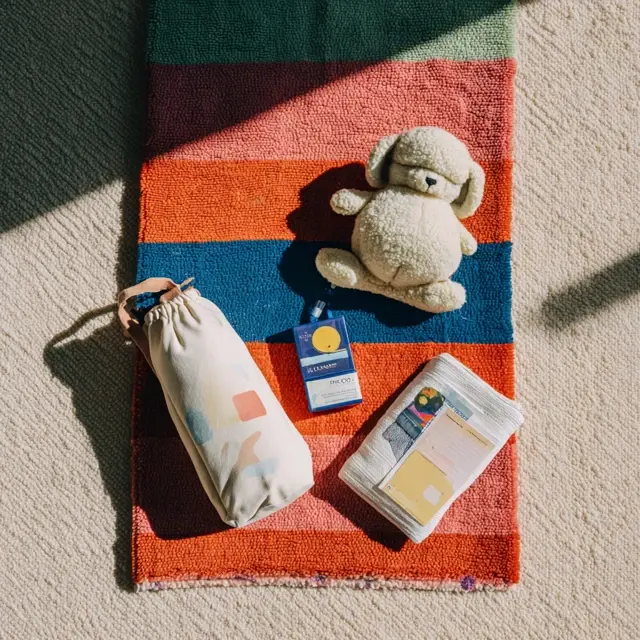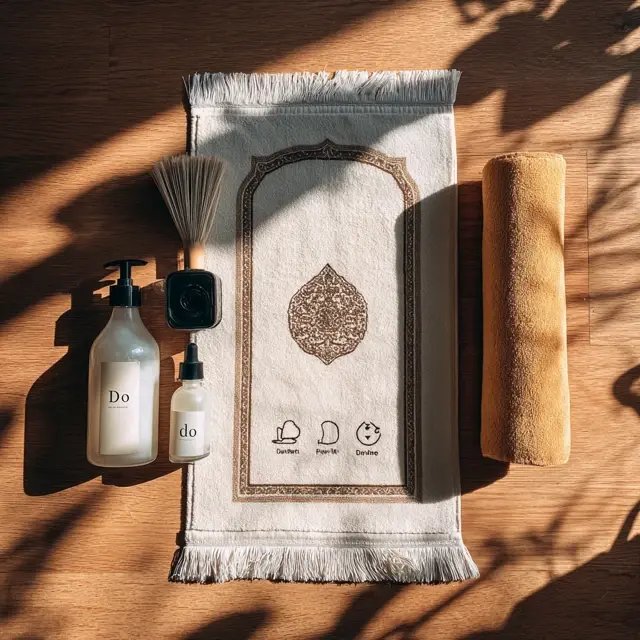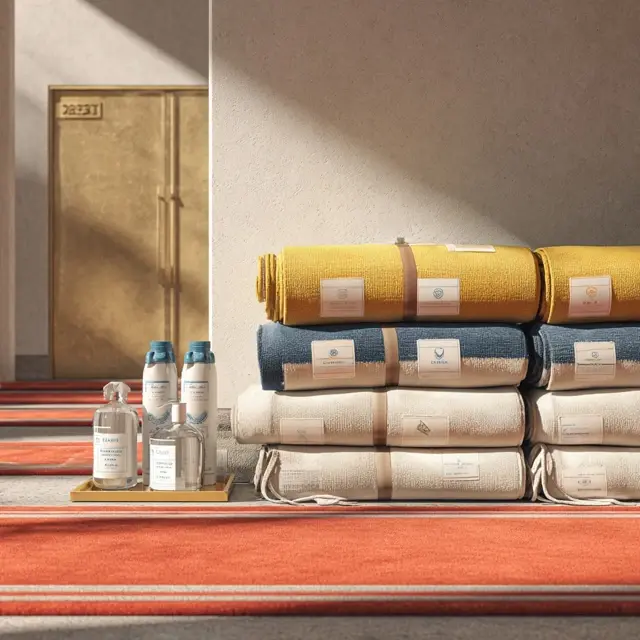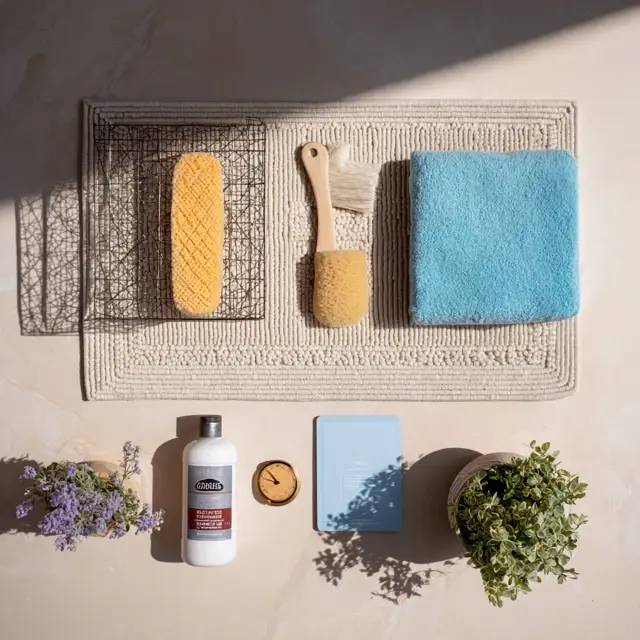Disinfecting a Prayer Mat After Illness
When someone at home has been unwell, it’s smart to refresh high-touch textiles—your prayer mat included. Because mats combine dyed fabrics, pile, and sometimes non-slip or foam backings, the goal is effective hygiene without color loss, pile crush, or adhesive damage. Follow this fabric-aware plan.
Step 0: Assess & Plan
- Identify zones: Head and hand panels see the most contact—prioritize them.
- Check the care label: If it says “machine washable,” the laundering route may be safest. If missing or delicate, use the spray-and-dry method below.
- Test for colorfastness: Dab a hidden corner with your chosen solution; proceed only if no dye transfer occurs.
What You’ll Need
- Disposable gloves and a timer (for contact time)
- Microfiber cloths (at least two)
- Fabric-safe soft-surface sanitizer (fine-mist), or a laundry sanitizer additive if washing is allowed
- Dye-free liquid detergent (for pre-cleaning)
- Fan for airflow and a rack or two parallel rods for drying
Step 1: Pre-Clean So Sanitizer Can Work
- Shake outdoors to remove dust.
- HEPA vacuum with a brush attachment in the direction of the pile (slow, overlapping passes).
- Soil lift: Lightly tamp soiled spots with a cloth dipped in a mix of 1 tsp dye-free detergent : 1 cup cool water. Blot with a second cloth dampened in plain water. Avoid soaking.
Step 2: Choose Your Disinfection Route
Route A — Launder & Sanitize (Label Allows)
- Place the mat in a mesh laundry bag; add towels to balance the drum.
- Use cold delicate + half-dose dye-free detergent. Add a textile sanitizer per label directions.
- After the cycle, run an extra rinse if the product recommends it for skin-contact items.
Route B — Spray & Air (Label Missing / Delicate)
- Lay the mat flat on a rack or hang over two rods so it’s supported.
- Mist a fabric-safe soft-surface disinfectant from 6–8 in. away until evenly damp (not wet), focusing on head/hand panels.
- Start the timer: Keep the surface damp for the full contact time on the label. If an area dries early, re-mist lightly.
Material-Specific Guardrails
Cotton & Polyester (Textile Backing)
- Both routes above are typically compatible; cold water and low agitation protect color.
- Skip chlorine bleach on patterned pieces; use color-safe options if laundering.
Microfiber / Printed Faces
- Prefer the spray & air route with a fine mist; avoid solvent-heavy spotters on the print layer.
- Keep contact time exact and avoid oversaturation along printed edges.
Wool & Velvet Piles
- Use a wool-safe, fabric-rated sanitizer and the lightest effective mist. No scrubbing across the nap.
- After drying, lift the nap with a soft brush to restore uniform sheen.
Non-Slip (Latex/TPR) or Foam-Cushioned Backings
- Treat the face with a fine mist only; for the back, use a lightly dampened cloth rather than soaking.
- Dry flat with airflow; heat and pooled liquid can ripple or soften coatings.
Step 3: Rinse (If Label Says) & Dry for Keeps
- If the product label requires rinsing for items that touch skin, perform a wipe-rinse with a clean, water-damp cloth.
- Press-dry between towels (no wringing), then dry in shade with a fan until the back feels fully dry.
- Finish by grooming the pile in its natural direction.
Contact Time Quick Table
| Surface | Method | Coverage | Contact Time |
|---|---|---|---|
| Textile face (cotton/poly) | Fabric-safe disinfectant mist | Even, light dampness | Per product label (keep damp) |
| Printed/microfiber | Fine mist only | Target head/hand zones | Per label; avoid overspray |
| Wool/velvet | Wool-safe sanitizer | Minimal mist | Shortest label-compliant |
| Non-slip/foam backing | Damp cloth wipe | Thin, even film | Per label; no pooling |
Common Mistakes to Avoid
- Oversaturation: Driving liquid into the core extends dry time and risks warping.
- Skipping pre-clean: Soil can block sanitizer performance.
- Heat drying: Radiators or hot dryers can set stains and damage coatings.
- Mixing chemicals: Never combine bleach with acids or ammonia.
After-Care & Prevention
- Air after each use for 15–20 minutes in shade to keep moisture low.
- Rotate orientation for a few days to distribute handling on freshly treated areas.
- Store breathable: roll (don’t fold) in a cotton or muslin bag on a cool, shaded shelf.
Troubleshooting
- Residual odor: Ensure the backing is fully dry; add a nearby charcoal pouch during storage.
- Color looks dull: Wipe-rinse to remove residue, then groom the pile and air again.
- Tacky non-slip back: Extend flat, fan-assisted drying; avoid heat until fully smooth.
At-a-Glance Checklist
- ☐ Shake & HEPA vacuum
- ☐ Pre-clean soil (light tamp, no soak)
- ☐ Disinfect via launder+sanitizer or fabric-safe mist
- ☐ Honor full contact time
- ☐ Rinse if label requires
- ☐ Dry flat in shade with airflow; groom pile
Suggested internal link anchors: “Machine-Washing a Prayer Mat: Safe Settings,” “Hand-Washing a Prayer Mat: Gentle Method,” “Drying a Prayer Mat: Sun, Shade, or Indoors?”.




